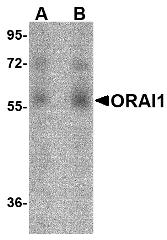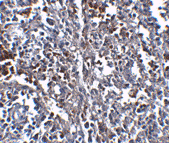Catalog# :PM-5205
Antigen stimulation of immune cells triggers Ca++ entry through Ca++ release-activated Ca++ (CRAC) channels. ORAI1 is a recently identified four-transmembrane spanning protein that is an essential component of CRAC. A missense mutation in this protein in humans is the cause of one fo rm of hereditary severe combined immune deficiency (SCID) which results in ablated T-cell Ca++ entry. It has been suggested that ORAI1 functions as a highly selective Ca++ plasma membrane channel that is gated through interactions with STIM1, the store-activated endoplasmic reticulum Ca++ sensor. ORAI1 often migrates at a higher than expected molecular weight in SDS-PAGE. This antibody is predicted to have no cross-reactivity to ORAI2 or ORAI3.
Additional Names : ORAI1 (3F6H5), Transmembrane protein 142A, TMEM142A, Calcium release-activated calcium channel protein 1
 Description
DescriptionLeft: Western blot analysis of ORAI1 in human ovary tissue lysate with ORAI1 antibody at (A) 1 and (B) 2 µg/ml.
Below:Immunohistochemistry of ORAI1 in human spleen tissue with ORAI1 antibody at 2.5 µg/ml.
Other Product Images

Source :Mouse monoclonal ORAI1 antibody was raised against a 16 amino acid peptide from near the carboxy terminus of human ORAI1.
Purification : Immunoaffinity chromotography purified IgG
Clonality and Clone : This is a monoclonal antibody. (Clone 3F6H5)
Host : ORAI1 monoclonal antibody was raised in mouse.
Please use anti-mouse secondary antibodies.
Immunogen : Mouse monoclonal ORAI1 antibody was raised against a 16 amino acid peptide from near the carboxy terminus of human ORAI1.
Application : ORAI1 antibody can be used for detection of ORAI1 by Western blot at 1 – 2 µg/ml.
Tested Application(s) : E, WB, IHC
Buffer : Antibody is supplied in PBS containing 0.02% sodium azide.
Blocking Peptide :
Long-Term Storage : ORAI1 monoclonal antibody can be stored at 4ºC, stable for one year.
Positive Control :
1. Cat. No. 1316 - Human Ovary Tissue Lysate
Species Reactivity : H, M, R
Short Description : a T cell calcium channel
References
1. Lewis RS. Calcium signaling mechanisms in T lymphocytes. Annu. Rev. Immunol. 2001; 19:497-521.
2. Feske S, Gwack Y, Prakriya M, et al. A mutation in Orai1 causes immune deficiency by abrogating CRAC channel function. Nature 2006; 441:179-85.
3. Soboloff J, Spassova MA, Dziadek MA, et al. Calcium signals mediated by STIM and Orai proteins – a new paradigm in inter-organelle communication. Biochim. Biophys. Acta. 2006; 1763:1161-8.

No comments:
Post a Comment